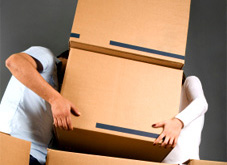
There is something uplifting about moving: a new home is a new beginning and packing becomes a purifying ritual, a time to decide what you will take and what you will leave. Packing for a move is the packrat’s only true redemption. When else are they likely to discard, recycle or donate the mountains of clothes, unread magazines, and knickknacks? Packrat or not it can seem like a daunting task. Take a deep breath and meditate on this phrase: packing can be pleasant. All you need to know are a few tricks from the masters.
Whether you are moving across town or across the country, it’s a good idea to pack a box of basic necessities and if possible transport the box with you to your new home rather than putting it in the moving truck. In case of any unforeseen delays in the arrival of your belongings, you won’t be completely inconvenienced. Keeping the box with you also means you won’t have to dig through stacks of boxes when you get to your new house. Some ‘must-haves’ are shampoo, soap, coffee mugs, tea or instant coffee, pens, paper, a small box of laundry detergent, scissors, a few washcloths and towels, toothbrush, toothpaste, plastic utensils and paper plates. (If you have not mastered the Zen of unpacking you may also want to add aspirin to your box of essentials!)
Packing breakables can be the most time consuming part of preparing for your move. Each glass, cup, plate, and bowl must be wrapped. Most of us use old newspaper but the ink can become messy. Try wrapping your plates in tablecloths, dishtowels, clothes or bath towels. Using fabric items as the actual wrapping material saves space and weight-you would have had to pack them up regardless but this way you do not transport unneeded newspaper which will just end up in a crumpled pile in your new kitchen.
You may be surprised at how expensive boxes can be if you decide to buy them from your movers or other packing suppliers. Veteran movers are in the know on the best places to find free, sturdy boxes: grocery and furniture stores receive most of their inventory in boxes which must be disposed of. These merchants are usually happy to give these away but try to ask for boxes in the first two weeks of any month; lots of other people have the same idea and there may be none left if you wait until the end of the month. If you work in a large office which frequently updates its computer equipment, ask for these particularly strong boxes in anticipation of your move. If you have storage space and plan to move again within a few years, hold onto the coveted computer boxes.
A great way to save time is to use a system of coloured labels. Even if you don’t consider yourself ultra-organized, it’s a simple time-saver. Buy large office labels in four or five colours and use different colours to denote different parts of the house (ex. yellow for the kitchen, blue for the bathroom etc.) Colour coding can be a quick visual reference.
No self-respecting mover would ever admit to it but sometimes boxes get left in the rain just a little too long. The result is wet belongings and occasionally clothes get ruined when colours bleed from dark to light fabrics. It’s a good idea to place any moisture-sensitive items in clean plastic bags before packing in boxes.
A few reminders:
- Always pack the heaviest objects on the bottom and work up to those which are light and breakable.
- Chemical cleaners should never share a box with food even those items which are canned or unopened.
- Criss-cross tape across the bottom of boxes then up the sides to prevent boxes from breaking open.
Hopefully, by keeping these tips in mind, you will manage to avoid any moving mishaps and make the first days in your new home as special as they should be.
